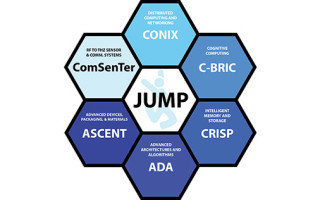DARPA launches six research centers for microelectronics research
NewsJanuary 22, 2018

ARLINGTON, Va. DARPA and officials at the Joint University Microelectronics Program (JUMP) selected six centers that will undertake high-risk, high-payoff research that addresses existing and emerging challenges in microelectronic technologies.
DARPA and the Semiconductor Research Corporation (SRC) - which serves as the administrative hub - started collaborating in 2016 to recruit a consortium of cost-sharing industry partners that includes Analog Devices, ARM, EMD Performance Materials (a Merck KGaA affiliate), IBM Corp., Intel Corp., Lockheed Martin Corp., Micron Technology, Inc., Northrop Grumman Corp., Raytheon Co., TSMC, and Samsung.
The consortium conducted a search for university research proposals throughout 2017 with the goal of uncovering innovative approaches to solving tough development challenges around microelectronics. The six JUMP research centers comprised of academic researchers from over 30 U.S. universities began exploratory research initiatives this year that JUMP organizers hope will impact defense and commercial opportunities in the coming decades.
“The point of JUMP and its six thematic centers is to drive a new wave of fundamental research with the potential to deliver the disruptive microelectronics-based technologies required by the Department of Defense and national security in the 2025-2030 timeframe,” explains Linton Salmon, DARPA’s program manager for JUMP. “Through these university teams, we’re seeking innovative solutions to tough technical challenges so that we can overcome today’s limitations in the performance and scalability of electronic systems. This in turn will open the way to technologies that dramatically boost the warfighter’s abilities to sense the environment, process information, and communicate.”
Funding for the five-year effort is expected to total approximately $200 million, with DARPA providing about 40 percent of the funding and consortium partners collectively kicking in about 60 percent.
Four of the successful proposals to participate in the JUMP program fall under the category “vertical” application-focused centers and two fall under the category “horizontal” disciplinary-focused centers.
Within the JUMP context, the challenges of the “vertical” research centers focus on accomplishing application-oriented goals and spurring the development of complex systems with capabilities well beyond those available today. Diving deep into cognitive computing, intelligent memory and storage, distributed computing and networking, and RF to THz sensor and communications systems, among other areas, these research centers will strive to develop systems that will be transferable to military and industry in a five year timeframe and fieldable in 10.
The four vertical JUMP centers are:
- Center for Brain-inspired Computing Enabling Autonomous Intelligence (C-BRIC)
- Center for Converged TeraHertz Communications and Sensing (ComSecTer)
- Computing On Network Infrastructure for Pervasive Perception, Cognition, and Action (CONIX)
- Center for Research on Intelligent Storage and Processing-in-memory (CRISP)
In addition, two “horizontal” research centers will take on the challenge of driving foundational developments around specific disciplines with the goal of creating disruptive breakthroughs in areas relevant to JUMP sponsors, including advanced architectures and algorithms, and advanced devices, packaging, and materials.
The two horizontal JUMP centers include:
- Applications Driving Architectures (ADA) Center
- Applications and Systems driven Center for Energy-Efficient Integrated Nanotechnologies (ASCENT)
JUMP and its efforts to build-up a foundational research base in fields underlying microelectronics technologies are part of DARPA’s Electronics Resurgence Initiative (ERI). Over the next four years, the ERI will commit hundreds of millions of dollars to ensure far-reaching improvements in electronics performance well beyond the limits of traditional scaling. Central to the ERI are new forward-looking collaborations among the commercial electronics community, defense industrial base, university researchers, and the DoD. The partnerships created across industry, academia, and the defense community through JUMP are one of several critical components advancing ERI and its efforts to foster the environment needed for the next wave of U.S. semiconductor technology innovations.
For more information about JUMP and the six research centers supporting this collaborative effort, visit the SRC’s website.






